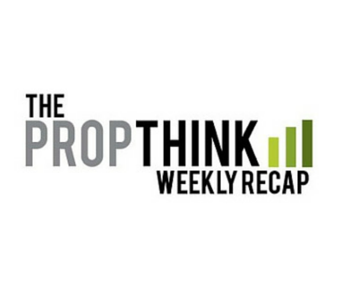Small-caps took the brunt of this week’s selling, with the Russell 2000 and iShares NASDAQ Biotechnology ETF (IBB) both down 5%, and the more evenly weighted (more exposure to small biotechnology companies) SPDR Biotechnology ETF (XBI) down a whopping 7%.
Technical analysis isn’t everything, but it’s worth noting that the S&P 500 is sitting right at a major support area. Below is a chart of the SPY, an Exchange-Traded Fund that tracks the S&P 500 (SPX).

The SPY closed Friday RIGHT at its 200-Day Simple Moving Average (190.5), and a level of previous congestion (horizontal yellow line). This, the 190.5 (1905 for the S&P) area, is a key level to watch: a confirmed break, or close below, likely means we have further to fall. So far, we’re about 5% off of all-time highs, well shy of the “10%” that financial pundits are so keen to consider “a true correction.” With that in mind, lets take a look at a weekly chart going back to 2009. We’re looking for the next level at which we might see support if 190.5 does break, certainly not out of the question.

On the chart above, it becomes clear why ~180 is also an important level. First, 180 would represent the 10% that so many investors look to as the official confirmation of a “correction.” Second, 181 has provided resistance and support for the SPY/SPX in the past, signified by the horizontal purple line in the chart above. Third, this area also corresponds with a 23% Fibonacci Retracement when applied to the current trend, a tool that many chartists use when analyzing a pull-back. While these exact levels are malleable, looking at 181 as a major test of support if 190 fails certainly makes sense. (Note also that the S&P is quite close to its 50-day Moving Average based on a weekly view).
Alcobra (ADHD) reported results on Monday morning from a phase 3 trial of metadoxine sustained-release in adult ADHD patients. While the company spun the results as positive based on a modified Intent to Treat (mITT) analysis, the market (ourselves included) took a dim view. Alcobra reported that in a modified Intent To Treat (mITT) population (n=293), metadoxine demonstrated a statistically significant improvement in ADHD symptoms compared to placebo. The mITT population excluded four subjects with extreme placebo responses that the company says were inconsistent with previous ADHD trials: their own and others. The company justified the exclusions via the 68-95-99.7 3-Sigma Rule on normal distributions. Of note, the company DID apply the same logic to the metadoxine arm and had no major outliers. Excluding patients because they didn’t fit the bill is a no-no, in our view; it’s difficult to imagine the FDA signing off on this trial as one of two registration studies needed for approval.
Alcobra was not clear about their plans for future studies but suggested that FDA has in the past accepted these kinds of mITT analyses. Alcobra had pre-specified the three-sigma outlier statistical plan that allowed for the 4-patient exclusion, but revealed on a conference call Monday morning that this component had not been submitted to the FDA prior.
FDA won’t be thrilled with the exclusion. The question is whether FDA will want Alcobra to run two additional phase 3 trials or be comfortable accepting this phase 3 as one of two required registration trials.
Further, replicating the mITT success isn’t a shoe-in. On top of the complicated phase 3 results, the MOA for metadoxine is still unclear, the asset’s IP is far from bulletproof, and the company will need to raise meaningful capital to get across the goal-line. We’ve outlined in the past why we’re cautious about the longterm commercial story.
We had expressed a hedged long bias into the ADHD results on the thesis that the Primarily Inattentive subgroup (PI-ADHD, 39% of subjects) stood a high likelihood of driving top-line success in the phase 3 trial. Additionally, an Intent-to-Treat (ITT) miss but PI-ADHD hit would have been received by the buyside as net-positive, with ADHD on a path (albeit an ill-defined path) towards FDA approval in this subpopulation. For those that executed our long-biased trade, the loss was around 25%. We also expressed a “non-directional” trade for the binary event, taking advantage of ADHD’s options pricing in a tremendous move from the stock. That trade produced a very nice profit (depending on number of three-contract positions placed) as volatility in ADHD options rapidly disappeared. All-in, we liked the risk/reward structured with the long-biased view (a 1:3 ratio), though the 2nd was the safer trade. You can read our full take on the Alcobra results here.
Also on Monday morning, Sunesis Pharmaceuticals (SNSS) announced the failure of VALOR, a phase 3 trial testing vosaroxin in refractory and relapsed acute myeloid leukemia (AML). Vosaroxin in combination with a standard treatment for AML, cytarabine, produced a median overall survival of 7.5 months, compared to 6.1 months for cytarabine plus a placebo (p=0.06). The difference was not statistically significant. Although never a pick at PropThink, we discussed on Twitter (if you’re not following PropThink, you should be!) why we were not optimistic about the trial.
Cytarabine meaningfully outperformed the company’s assumptions when they designed VALOR back in 2009/10; this was the crux of our negative view. Data that has emerged in the four years since VALOR began suggests cytarabine is far more effective than Sunesis took into account. Additionally, other topoisomerase II inhibitors, like vosaroxin, have not improved patient survival meaningfully when added to cytarabine. The SNSS long thesis hinged largely on a 2012 sample size increase for VALOR and improved power with which Sunesis expected to detect (with statistical significance) this OS benefit. Interestingly, it was Monday’s very scenario that SNSS and its investors hoped the phase 3 VALOR trial could avoid: a one-month-plus OS improvement that did NOT produce statistical significance. (Read more at PropThink.com)
Endo Health (ENDP) and Auxilium Pharmaceuticals (AUXL) finally came to terms in ongoing buyout negotiations, with ENDP handing over $2.6 billion for the smaller men’s health company.
This leaves QLT Inc (QLTI) out in the cold. QLT and Auxilium had been in the midst of their own merger, and AUXL is now obligated to pay QLTI a $28.4 million breakup fee: that’s $0.55 per share cash on a $4.00 stock.
On Thursday, we outlined why we again like the idea of owning QLTI (we traded out of QLTI in June when the AUXL merger was announced). The company has $3.22 per share in cash; a shareholder-friendly board/executive team; and we suspect the company can formulate a strategic exit one way or another. Using the previous AUXL merger as a proxy, QLTI should be able to get another deal done in the $6-range. We like the risk/reward putting money to work on the long side in QLTI around $4.00, especially as the market continues to chop.
Read “QLT Inc. Left by Auxilium: Favorable Risk/Reward in Uncertain Market” for FREE at PropThink.com
Also note, three size-able funds still own >30% of QLTI: Axial Capital (8.865M shares), Kingstown Capital (3.25M shares), and Visium Capital (4.319M). All three of these funds entered into a Voting Agreement with Auxilium at the time of the merger, under which they committed to vote in favor of the planned transaction. Clearly, these shareholders are in favor of an opportune exit and have the clout to nudge the company in the right direction.
Get a month of our proprietary trades and biotechnology equity research for $49.
CLICK HERE
Late-breaking abstracts from AASLD’s upcoming The Liver Meeting were published on Tuesday morning, and a number of companies felt the impact. The most high-profile market reaction: Arrowhead Pharmaceuticals’ (ARWR) late-breaking abstract on ARC-520, an RNAi therapeutic for the treatment of chronic Hepatitis B. Two events put incredible pressure on ARWR on Wednesday: data from a competing, development-stage product and seriously underwhelming data from its own therapeutic. ARWR dropped 40% in the session. Get details on Conatus Pharma (CNAT), Intercept (ICPT), and ARWR’s presence at AASLD by clicking here.
One or more of PropThink’s contributors are long AUXL, ENDP, QLTI, or CNAT.



